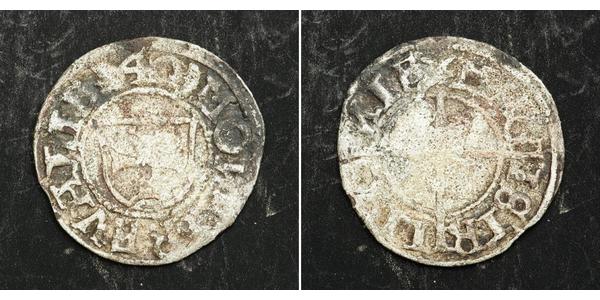(Venduta per $1.0)
1549, Estonia/Livonian Order, Silver Solidus Coin. Tallinn (Reval) mint. F+
Denomination: Solidus Condition: Corroded F+ Mint Period: 1535-1549 AD Diameter: 18mm Weight: 0.82gm Material: Silver
Obverse: Shield with cross (arms of the Livonian Order) within inner circle. Legend: * 4 * MONE REVALIE
Reverse: Long-cross splitting legend on inner circle. Legend: MAG ISIR ... ONIF
The Livonian Order was an autonomous branch of the Teutonic Order, formed in 1237. It was later a member of the Livonian Confederation, from 1435 to 1561.
The order was formed from the remnants of the Livonian Brothers of the Sword after their defeat by Samogitians in 1236 at the Battle of Schaulen (Saule). They were incorporated into the Teutonic Knights and became known as the Livonian Order in 1237. Between 1237 and 1290, the Livonian Order conquered all of Courland, Livonia and Semigallia. In 1298, Lithuanians took Karkus Castle north of Riga, and defeated the order in the Battle of Turaida, killing Livonian Land Master Bruno and 22 knights. In 1346, the order bought the Duchy of Estonia from King Valdemar IV of Denmark. Life within the order's territory is described in the Chronicle of Balthasar Russow (Chronica der Provinz Lyfflandt).
The Teutonic Order fell into decline following its defeat in the Battle of Grunwald in 1410 and the secularization of its Prussian territories by Albert of Brandenburg in 1525, while the Livonian Order managed to maintain an independent existence.
The Livonian Order's defeat in the Battle of Swienta (Pabaiskas) on September 1, 1435, which claimed the lives of the master and several high-ranking knights, brought the order closer to its neighbors in Livonia. The Livonian Confederation agreement (eiine fruntliche eyntracht) was signed in Walk on December 4, 1435, by the Archbishop of Riga, the bishops of Courland, Dorpat, Ösel-Wiek and Reval; the representatives of the Livonan Order and vassals, and the deputies of Riga, Reval and Dorpat city municipal councils.
During the Livonian War, however, the order suffered a decisive defeat by troops of Muscovite Russia in the Battle of Ergeme in 1560. The Livonian Order then sought protection from Sigismund II Augustus, the King of Poland and the Grand Duke of Lithuania, who had intervened in a war between Bishop William of Riga and the Brothers in 1557.
After coming to an agreement with Sigismund II, Augustus and his representatives (especially Mikołaj "the Black" Radziwiłł), the last Livonian Master, Gotthard Kettler, secularized the order and converted to Lutheranism. In the southern part of the Brothers' lands he created the Duchy of Courland and Semigallia for his family. Most of the remaining lands were seized by the Grand Duchy of Lithuania. The north of Estonia was taken back by Denmark and Sweden.
From the 14th to the 16th centuries, Middle Low German as spoken in the towns of the Hanseatic League was the established language, but was subsequently succeeded by High German as official language in the course of the 16th and 17th centuries.
Only 1$ shipping for each additional coin purchased!
1 Thaler Sacro Romano Impero (962-1806) Argento Leopoldo I d ...
il gruppo ha 37 monete / 28 prezzi
⇑








-300-150-m2IKbzbihEYAAAFG09gOlZ5S.jpg)






